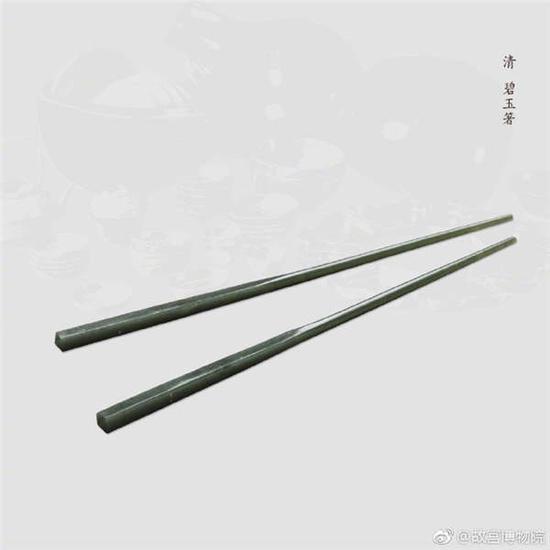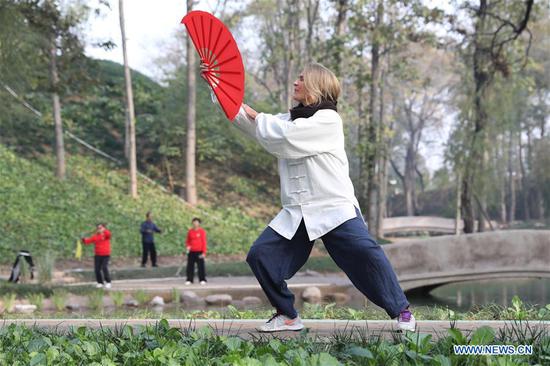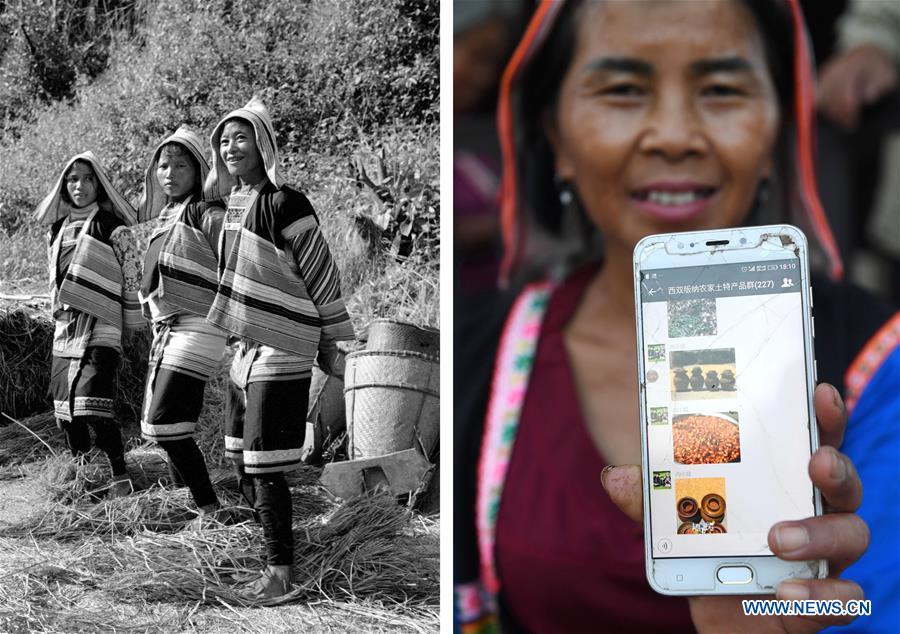
This combination photo shows Jino women separating grain seeds with their feet in 1984 (left, file photo); and Jino villager Li Xiuzhen showing a WeChat group for sales of local specialty goods in Baka Village of Jino Ethnic Township on Jino Mountain, Nov. 20, 2018 (right, photo by Lin Yiguang). With a population of slightly over 20,000, the Jino people had only been officially acknowledged in 1979 as an independent ethnic group of China. Until 1949, most of them had lived for generations in primitive mountain tribes in southwest China's Yunnan Province. Over the four decades since it embraced the reform and opening-up policy, China has spared no effort to support ethnic groups with smaller populations. Life on Jino Mountain, where most Jino communities are located, saw positive changes in parallel with improvements in local politics, economy, technology, education, culture, health care, ecology, ethnic development and other social undertakings. Just like its 55 ethnic brethren, the Jino people also benefit from China's reform and opening-up in seeking a prosperous life. In Jino Ethnic Township on the Jino Mountain, residents now have direct access to road, water, electricity, TV and radio, as well as the mobile network. Ninety percent of the residents have moved into new houses. Most residents own motorcycles and tractors, and some of them have purchased cars. More people have increased their income by selling local specialty products via the internet, whereas in the past, doing business was perceived as a shame. Currently, the primary education in Jino Ethnic Township achieved 100 percent coverage for all school-age children. More than 99 percent of residents have joined the rural cooperative medical insurance programme. The Jino ethnic culture undergoes protection and inheritance: the great drum dance of the Jino people has been listed as one of China's national intangible cultural heritages. (Xinhua)
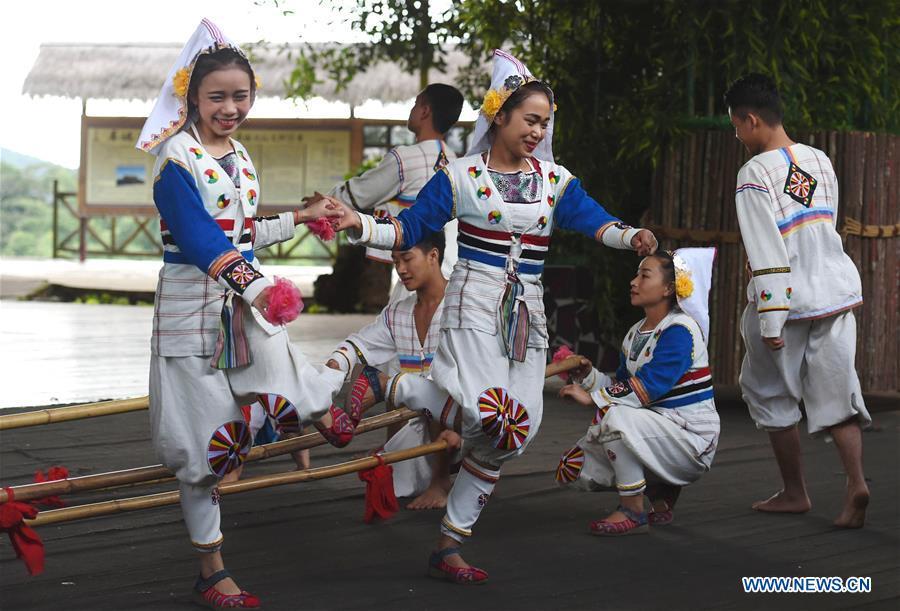
Jino youths perform a folk dance for tourists in Bapo Village of Jino Ethnic Township on Jino Mountain, Jinghong, in Xishuangbanna Dai Autonomous Prefecture, southwest China's Yunnan Province, Nov. 5, 2015. With a population of slightly over 20,000, the Jino people had only been officially acknowledged in 1979 as an independent ethnic group of China. Until 1949, most of them had lived for generations in primitive mountain tribes in southwest China's Yunnan Province. Over the four decades since it embraced the reform and opening-up policy, China has spared no effort to support ethnic groups with smaller populations. Life on Jino Mountain, where most Jino communities are located, saw positive changes in parallel with improvements in local politics, economy, technology, education, culture, health care, ecology, ethnic development and other social undertakings. Just like its 55 ethnic brethren, the Jino people also benefit from China's reform and opening-up in seeking a prosperous life. In Jino Ethnic Township on the Jino Mountain, residents now have direct access to road, water, electricity, TV and radio, as well as the mobile network. Ninety percent of the residents have moved into new houses. Most residents own motorcycles and tractors, and some of them have purchased cars. More people have increased their income by selling local specialty products via the internet, whereas in the past, doing business was perceived as a shame. Currently, the primary education in Jino Ethnic Township achieved 100 percent coverage for all school-age children. More than 99 percent of residents have joined the rural cooperative medical insurance programme. The Jino ethnic culture undergoes protection and inheritance: the great drum dance of the Jino people has been listed as one of China's national intangible cultural heritages. (Xinhua/Lin Yiguang)
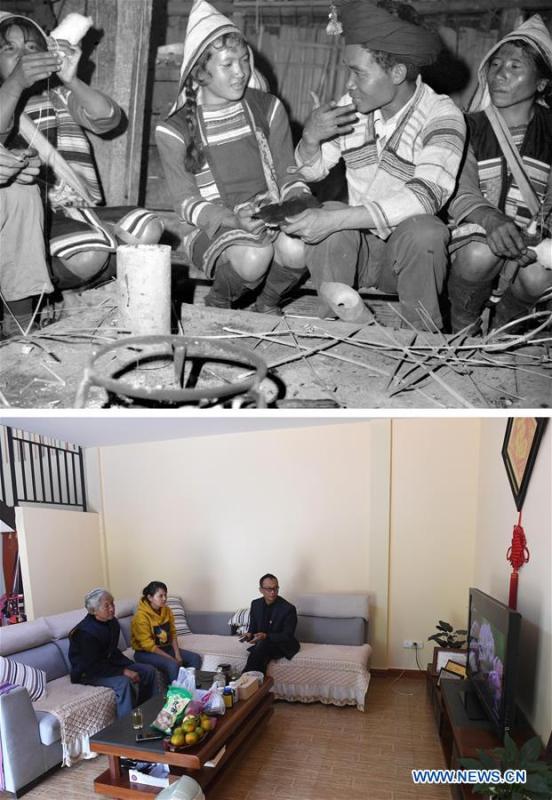
This combination photo shows Jino villagers chatting with each other in 1981 (above, file photo); and Jino senior citizen Ziqie (1st L) watching television program at his new residence with his family, Nov. 20, 2018 (below, photo by Lin Yiguang). With a population of slightly over 20,000, the Jino people had only been officially acknowledged in 1979 as an independent ethnic group of China. Until 1949, most of them had lived for generations in primitive mountain tribes in southwest China's Yunnan Province. Over the four decades since it embraced the reform and opening-up policy, China has spared no effort to support ethnic groups with smaller populations. Life on Jino Mountain, where most Jino communities are located, saw positive changes in parallel with improvements in local politics, economy, technology, education, culture, health care, ecology, ethnic development and other social undertakings. Just like its 55 ethnic brethren, the Jino people also benefit from China's reform and opening-up in seeking a prosperous life. In Jino Ethnic Township on the Jino Mountain, residents now have direct access to road, water, electricity, TV and radio, as well as the mobile network. Ninety percent of the residents have moved into new houses. Most residents own motorcycles and tractors, and some of them have purchased cars. More people have increased their income by selling local specialty products via the internet, whereas in the past, doing business was perceived as a shame. Currently, the primary education in Jino Ethnic Township achieved 100 percent coverage for all school-age children. More than 99 percent of residents have joined the rural cooperative medical insurance programme. The Jino ethnic culture undergoes protection and inheritance: the great drum dance of the Jino people has been listed as one of China's national intangible cultural heritages. (Xinhua)
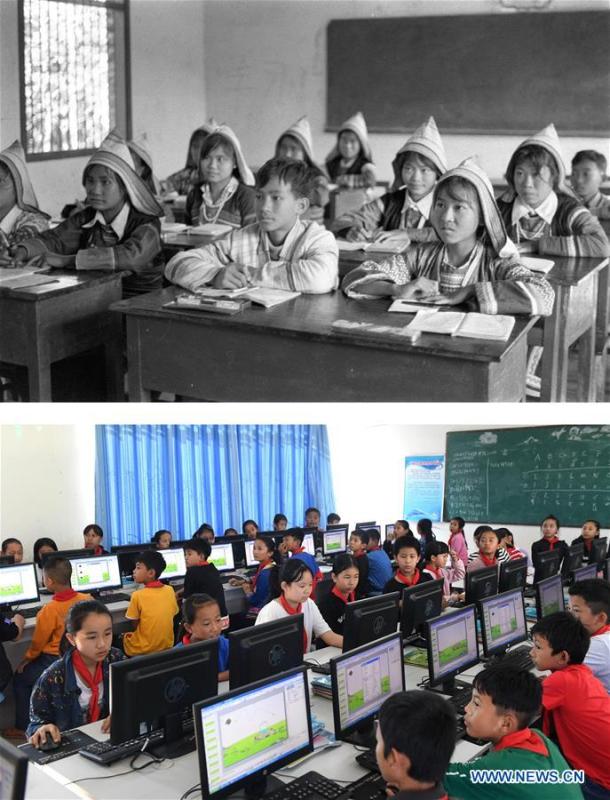
This combination photo shows Jino students attending a class on Jino Mountain in 1984 (above, file photo); and students taking a computer lesson at the Ethnic Primary School in Jino Ethnic Township on Jino Mountain, Nov. 20, 2018 (below, photo by Lin Yiguang). With a population of slightly over 20,000, the Jino people had only been officially acknowledged in 1979 as an independent ethnic group of China. Until 1949, most of them had lived for generations in primitive mountain tribes in southwest China's Yunnan Province. Over the four decades since it embraced the reform and opening-up policy, China has spared no effort to support ethnic groups with smaller populations. Life on Jino Mountain, where most Jino communities are located, saw positive changes in parallel with improvements in local politics, economy, technology, education, culture, health care, ecology, ethnic development and other social undertakings. Just like its 55 ethnic brethren, the Jino people also benefit from China's reform and opening-up in seeking a prosperous life. In Jino Ethnic Township on the Jino Mountain, residents now have direct access to road, water, electricity, TV and radio, as well as the mobile network. Ninety percent of the residents have moved into new houses. Most residents own motorcycles and tractors, and some of them have purchased cars. More people have increased their income by selling local specialty products via the internet, whereas in the past, doing business was perceived as a shame. Currently, the primary education in Jino Ethnic Township achieved 100 percent coverage for all school-age children. More than 99 percent of residents have joined the rural cooperative medical insurance programme. The Jino ethnic culture undergoes protection and inheritance: the great drum dance of the Jino people has been listed as one of China's national intangible cultural heritages. (Xinhua)
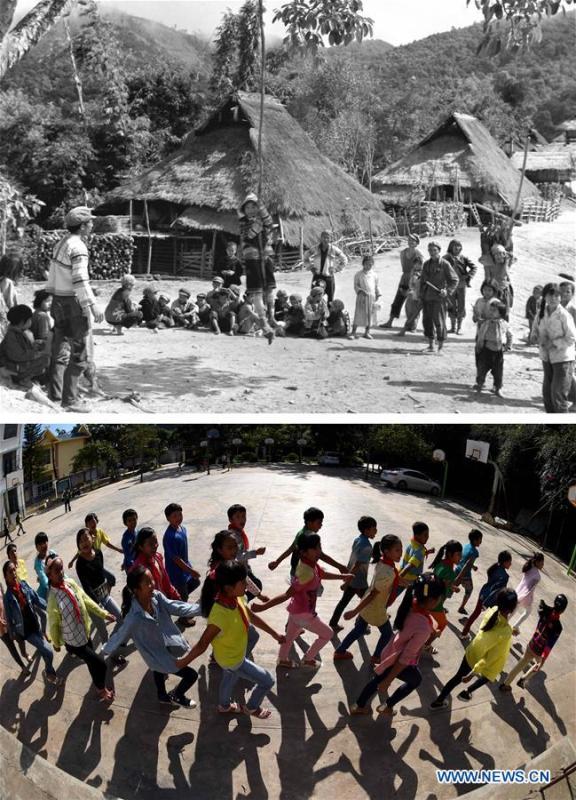
This combination photo shows Jino children taking part in a sports activity on Jino Mountain in 1983 (above, file photo); and students having a P.E. lesson at the Ethnic Primary School in Jino Ethnic Township on Jino Mountain, Nov. 4, 2015 (below, photo by Lin Yiguang). With a population of slightly over 20,000, the Jino people had only been officially acknowledged in 1979 as an independent ethnic group of China. Until 1949, most of them had lived for generations in primitive mountain tribes in southwest China's Yunnan Province. Over the four decades since it embraced the reform and opening-up policy, China has spared no effort to support ethnic groups with smaller populations. Life on Jino Mountain, where most Jino communities are located, saw positive changes in parallel with improvements in local politics, economy, technology, education, culture, health care, ecology, ethnic development and other social undertakings. Just like its 55 ethnic brethren, the Jino people also benefit from China's reform and opening-up in seeking a prosperous life. In Jino Ethnic Township on the Jino Mountain, residents now have direct access to road, water, electricity, TV and radio, as well as the mobile network. Ninety percent of the residents have moved into new houses. Most residents own motorcycles and tractors, and some of them have purchased cars. More people have increased their income by selling local specialty products via the internet, whereas in the past, doing business was perceived as a shame. Currently, the primary education in Jino Ethnic Township achieved 100 percent coverage for all school-age children. More than 99 percent of residents have joined the rural cooperative medical insurance programme. The Jino ethnic culture undergoes protection and inheritance: the great drum dance of the Jino people has been listed as one of China's national intangible cultural heritages. (Xinhua)
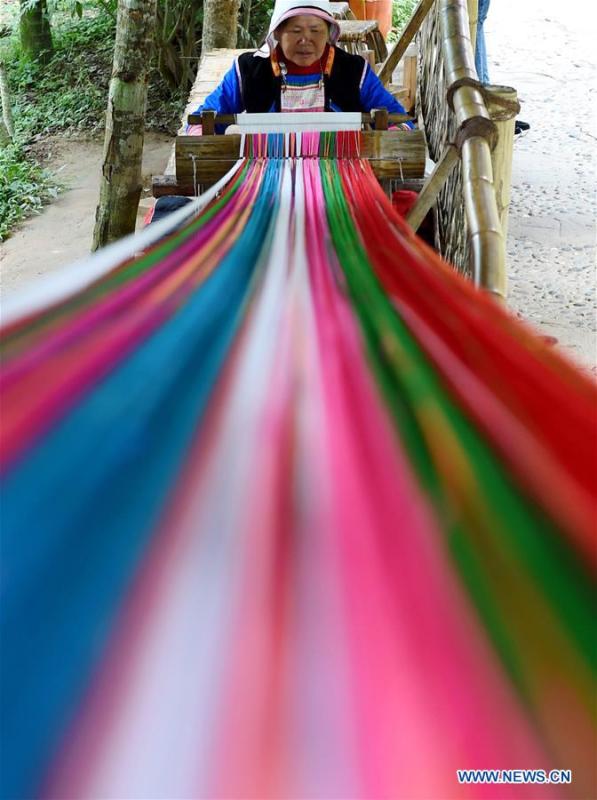
A Jino woman weaves cloths using a traditional hand loom in Bapo Village of Jinuo Ethnic Township on Jino Mountain in Jinghong of Xishuangbanna Dai Autonomous Prefecture, southwest China's Yunnan Province, Nov. 5, 2015. With a population of slightly over 20,000, the Jino people had only been officially acknowledged in 1979 as an independent ethnic group of China. Until 1949, most of them had lived for generations in primitive mountain tribes in southwest China's Yunnan Province. Over the four decades since it embraced the reform and opening-up policy, China has spared no effort to support ethnic groups with smaller populations. Life on Jino Mountain, where most Jino communities are located, saw positive changes in parallel with improvements in local politics, economy, technology, education, culture, health care, ecology, ethnic development and other social undertakings. Just like its 55 ethnic brethren, the Jino people also benefit from China's reform and opening-up in seeking a prosperous life. In Jino Ethnic Township on the Jino Mountain, residents now have direct access to road, water, electricity, TV and radio, as well as the mobile network. Ninety percent of the residents have moved into new houses. Most residents own motorcycles and tractors, and some of them have purchased cars. More people have increased their income by selling local specialty products via the internet, whereas in the past, doing business was perceived as a shame. Currently, the primary education in Jino Ethnic Township achieved 100 percent coverage for all school-age children. More than 99 percent of residents have joined the rural cooperative medical insurance programme. The Jino ethnic culture undergoes protection and inheritance: the great drum dance of the Jino people has been listed as one of China's national intangible cultural heritages. (Xinhua/Lin Yiguang)
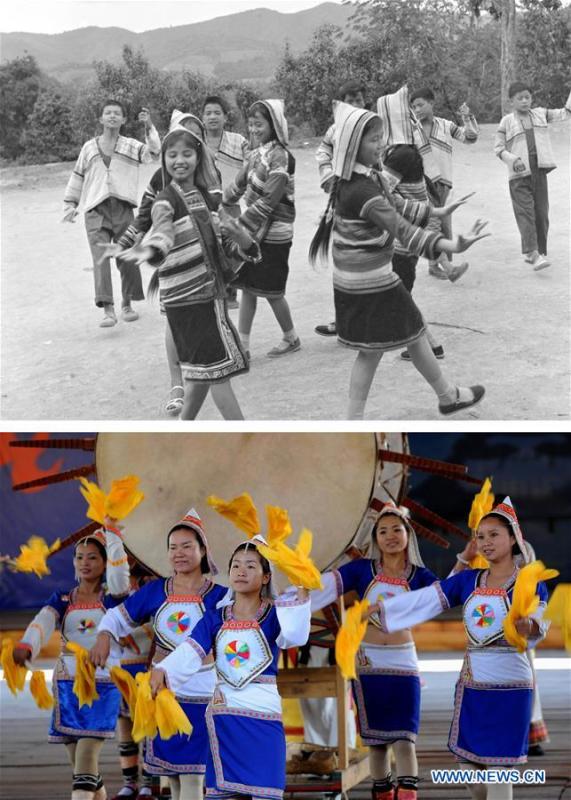
This combination photo shows Jino youths performing a folk dance in 1979 (above, file photo); and female Jino dancers performing the great drum dance in Bapo Village of Jino Ethnic Township on Jino Mountain, Feb. 25, 2011 (below, photo by Lin Yiguang). With a population of slightly over 20,000, the Jino people had only been officially acknowledged in 1979 as an independent ethnic group of China. Until 1949, most of them had lived for generations in primitive mountain tribes in southwest China's Yunnan Province. Over the four decades since it embraced the reform and opening-up policy, China has spared no effort to support ethnic groups with smaller populations. Life on Jino Mountain, where most Jino communities are located, saw positive changes in parallel with improvements in local politics, economy, technology, education, culture, health care, ecology, ethnic development and other social undertakings. Just like its 55 ethnic brethren, the Jino people also benefit from China's reform and opening-up in seeking a prosperous life. In Jino Ethnic Township on the Jino Mountain, residents now have direct access to road, water, electricity, TV and radio, as well as the mobile network. Ninety percent of the residents have moved into new houses. Most residents own motorcycles and tractors, and some of them have purchased cars. More people have increased their income by selling local specialty products via the internet, whereas in the past, doing business was perceived as a shame. Currently, the primary education in Jino Ethnic Township achieved 100 percent coverage for all school-age children. More than 99 percent of residents have joined the rural cooperative medical insurance programme. The Jino ethnic culture undergoes protection and inheritance: the great drum dance of the Jino people has been listed as one of China's national intangible cultural heritages. (Xinhua)
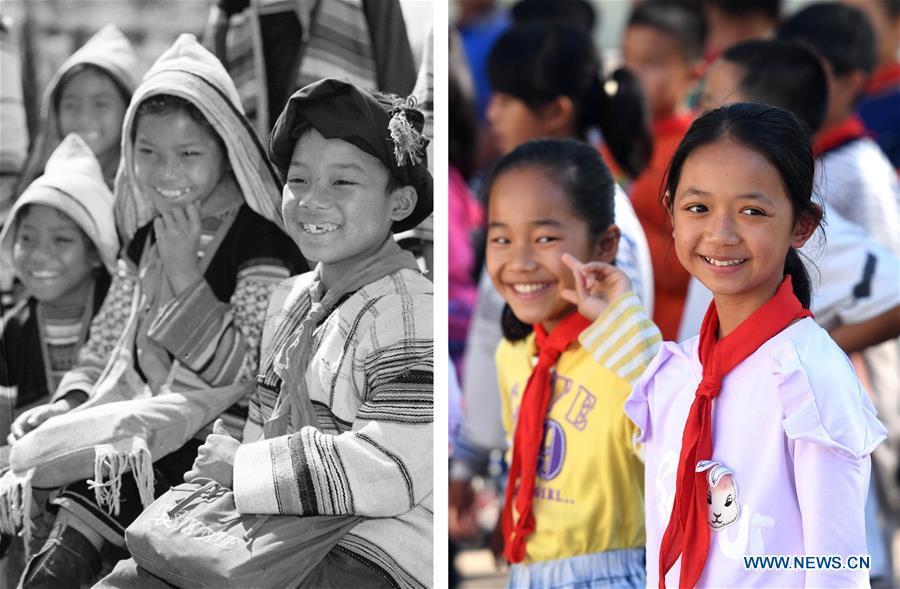
This combination photo shows Jino primary school students in 1984 (left, file photo); and students at the Ethnic Primary School in Jino Ethnic Township on Jino Mountain, Nov. 20, 2018 (right, photo by Lin Yiguang). With a population of slightly over 20,000, the Jino people had only been officially acknowledged in 1979 as an independent ethnic group of China. Until 1949, most of them had lived for generations in primitive mountain tribes in southwest China's Yunnan Province. Over the four decades since it embraced the reform and opening-up policy, China has spared no effort to support ethnic groups with smaller populations. Life on Jino Mountain, where most Jino communities are located, saw positive changes in parallel with improvements in local politics, economy, technology, education, culture, health care, ecology, ethnic development and other social undertakings. Just like its 55 ethnic brethren, the Jino people also benefit from China's reform and opening-up in seeking a prosperous life. In Jino Ethnic Township on the Jino Mountain, residents now have direct access to road, water, electricity, TV and radio, as well as the mobile network. Ninety percent of the residents have moved into new houses. Most residents own motorcycles and tractors, and some of them have purchased cars. More people have increased their income by selling local specialty products via the internet, whereas in the past, doing business was perceived as a shame. Currently, the primary education in Jino Ethnic Township achieved 100 percent coverage for all school-age children. More than 99 percent of residents have joined the rural cooperative medical insurance programme. The Jino ethnic culture undergoes protection and inheritance: the great drum dance of the Jino people has been listed as one of China's national intangible cultural heritages. (Xinhua)
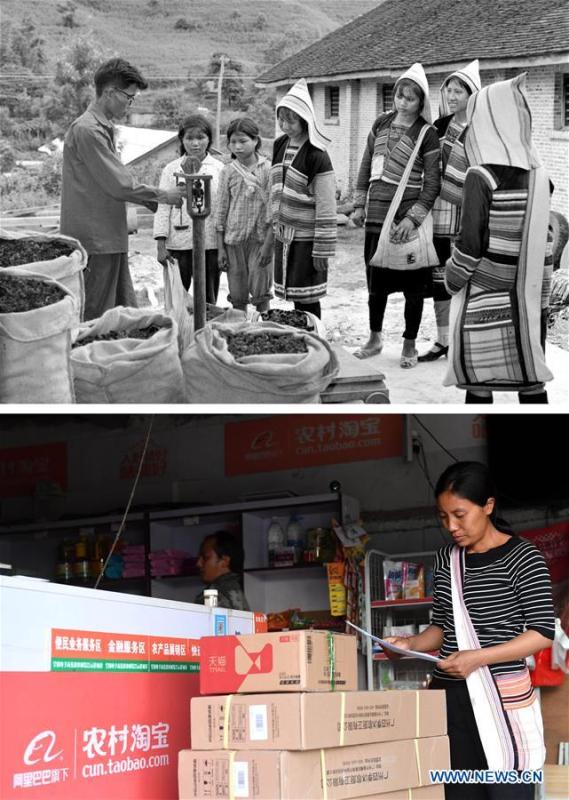
This combination photo shows Jino villagers selling edible fungi and bamboo shoots in 1981 (above, file photo); and Jino villager Li Xiaohui arranging goods at her own e-commerce center in Baduo Village of Jino Ethnic Township on Jino Mountain, Nov. 20, 2018 (below, photo by Lin Yiguang). With a population of slightly over 20,000, the Jino people had only been officially acknowledged in 1979 as an independent ethnic group of China. Until 1949, most of them had lived for generations in primitive mountain tribes in southwest China's Yunnan Province. Over the four decades since it embraced the reform and opening-up policy, China has spared no effort to support ethnic groups with smaller populations. Life on Jino Mountain, where most Jino communities are located, saw positive changes in parallel with improvements in local politics, economy, technology, education, culture, health care, ecology, ethnic development and other social undertakings. Just like its 55 ethnic brethren, the Jino people also benefit from China's reform and opening-up in seeking a prosperous life. In Jino Ethnic Township on the Jino Mountain, residents now have direct access to road, water, electricity, TV and radio, as well as the mobile network. Ninety percent of the residents have moved into new houses. Most residents own motorcycles and tractors, and some of them have purchased cars. More people have increased their income by selling local specialty products via the internet, whereas in the past, doing business was perceived as a shame. Currently, the primary education in Jino Ethnic Township achieved 100 percent coverage for all school-age children. More than 99 percent of residents have joined the rural cooperative medical insurance programme. The Jino ethnic culture undergoes protection and inheritance: the great drum dance of the Jino people has been listed as one of China's national intangible cultural heritages. (Xinhua)
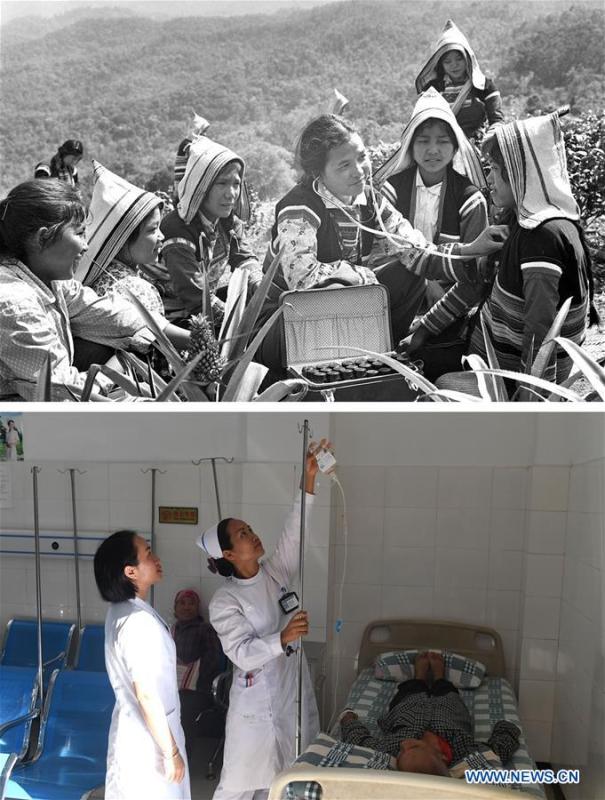
This combination photo shows Jino doctor Bai Lalei (C) giving medical treatment to villagers on Jino Mountain in 1977 (above, file photo); and Jino medical workers Zhou Yifang (1st L) and Zhou Jing (2nd L) giving intravenous injection for a patient at a local hospital in Jino Ethnic Township on Jino Mountain, Nov. 20, 2018 (below, photo by Lin Yiguang). With a population of slightly over 20,000, the Jino people had only been officially acknowledged in 1979 as an independent ethnic group of China. Until 1949, most of them had lived for generations in primitive mountain tribes in southwest China's Yunnan Province. Over the four decades since it embraced the reform and opening-up policy, China has spared no effort to support ethnic groups with smaller populations. Life on Jino Mountain, where most Jino communities are located, saw positive changes in parallel with improvements in local politics, economy, technology, education, culture, health care, ecology, ethnic development and other social undertakings. Just like its 55 ethnic brethren, the Jino people also benefit from China's reform and opening-up in seeking a prosperous life. In Jino Ethnic Township on the Jino Mountain, residents now have direct access to road, water, electricity, TV and radio, as well as the mobile network. Ninety percent of the residents have moved into new houses. Most residents own motorcycles and tractors, and some of them have purchased cars. More people have increased their income by selling local specialty products via the internet, whereas in the past, doing business was perceived as a shame. Currently, the primary education in Jino Ethnic Township achieved 100 percent coverage for all school-age children. More than 99 percent of residents have joined the rural cooperative medical insurance programme. The Jino ethnic culture undergoes protection and inheritance: the great drum dance of the Jino people has been listed as one of China's national intangible cultural heritages. (Xinhua)
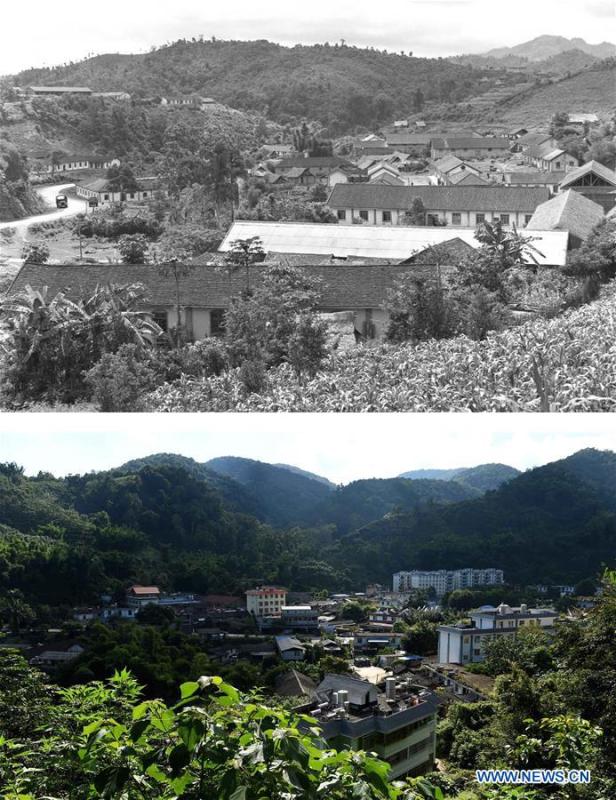
This combination photo shows a corner of Jino Mountain in 1979 (above, file photo); and the local government and its surroundings in Jino Ethnic Township on Jino Mountain on Nov. 4, 2015. (below, photo by Lin Yiguang). With a population of slightly over 20,000, the Jino people had only been officially acknowledged in 1979 as an independent ethnic group of China. Until 1949, most of them had lived for generations in primitive mountain tribes in southwest China's Yunnan Province. Over the four decades since it embraced the reform and opening-up policy, China has spared no effort to support ethnic groups with smaller populations. Life on Jino Mountain, where most Jino communities are located, saw positive changes in parallel with improvements in local politics, economy, technology, education, culture, health care, ecology, ethnic development and other social undertakings. Just like its 55 ethnic brethren, the Jino people also benefit from China's reform and opening-up in seeking a prosperous life. In Jino Ethnic Township on the Jino Mountain, residents now have direct access to road, water, electricity, TV and radio, as well as the mobile network. Ninety percent of the residents have moved into new houses. Most residents own motorcycles and tractors, and some of them have purchased cars. More people have increased their income by selling local specialty products via the internet, whereas in the past, doing business was perceived as a shame. Currently, the primary education in Jino Ethnic Township achieved 100 percent coverage for all school-age children. More than 99 percent of residents have joined the rural cooperative medical insurance programme. The Jino ethnic culture undergoes protection and inheritance: the great drum dance of the Jino people has been listed as one of China's national intangible cultural heritages. (Xinhua)

This combination photo shows Jino villager Yaoze (2nd L) having steamed rice with her family members and friends in 1984 (above, file photo); and Yaoze (1st L) taking care of her two grandsons along with her daughter-in-law (1st R) on Nov. 20, 2018 (below, photo by Lin Yiguang). With a population of slightly over 20,000, the Jino people had only been officially acknowledged in 1979 as an independent ethnic group of China. Until 1949, most of them had lived for generations in primitive mountain tribes in southwest China's Yunnan Province. Over the four decades since it embraced the reform and opening-up policy, China has spared no effort to support ethnic groups with smaller populations. Life on Jino Mountain, where most Jino communities are located, saw positive changes in parallel with improvements in local politics, economy, technology, education, culture, health care, ecology, ethnic development and other social undertakings. Just like its 55 ethnic brethren, the Jino people also benefit from China's reform and opening-up in seeking a prosperous life. In Jino Ethnic Township on the Jino Mountain, residents now have direct access to road, water, electricity, TV and radio, as well as the mobile network. Ninety percent of the residents have moved into new houses. Most residents own motorcycles and tractors, and some of them have purchased cars. More people have increased their income by selling local specialty products via the internet, whereas in the past, doing business was perceived as a shame. Currently, the primary education in Jino Ethnic Township achieved 100 percent coverage for all school-age children. More than 99 percent of residents have joined the rural cooperative medical insurance programme. The Jino ethnic culture undergoes protection and inheritance: the great drum dance of the Jino people has been listed as one of China's national intangible cultural heritages. (Xinhua)
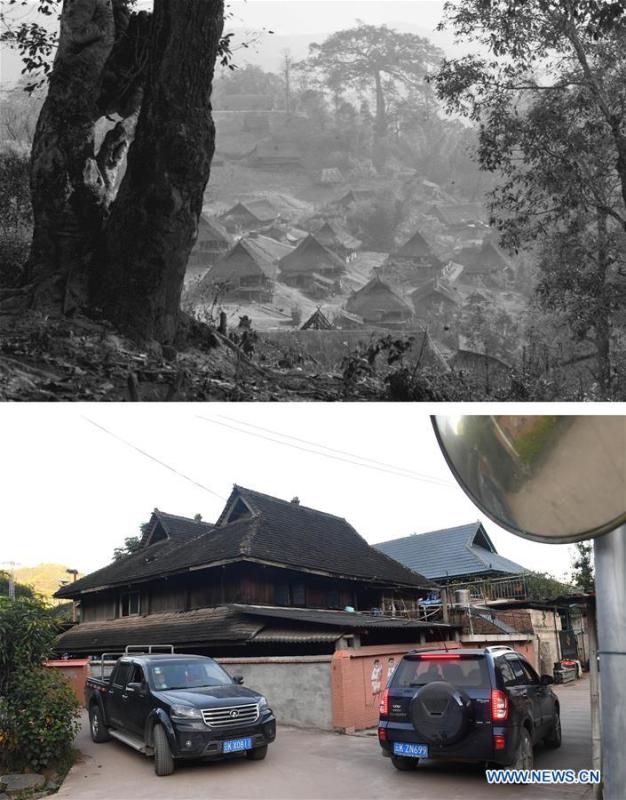
This combination photo shows Jino cottages made of straw on Jino Mountain in 1983 (above, file photo); and new residences as well as motor vehicles in Bapiao Village of Jino Ethnic Township on Jino Mountain, Nov. 20, 2018 (below, photo by Lin Yiguang). With a population of slightly over 20,000, the Jino people had only been officially acknowledged in 1979 as an independent ethnic group of China. Until 1949, most of them had lived for generations in primitive mountain tribes in southwest China's Yunnan Province. Over the four decades since it embraced the reform and opening-up policy, China has spared no effort to support ethnic groups with smaller populations. Life on Jino Mountain, where most Jino communities are located, saw positive changes in parallel with improvements in local politics, economy, technology, education, culture, health care, ecology, ethnic development and other social undertakings. Just like its 55 ethnic brethren, the Jino people also benefit from China's reform and opening-up in seeking a prosperous life. In Jino Ethnic Township on the Jino Mountain, residents now have direct access to road, water, electricity, TV and radio, as well as the mobile network. Ninety percent of the residents have moved into new houses. Most residents own motorcycles and tractors, and some of them have purchased cars. More people have increased their income by selling local specialty products via the internet, whereas in the past, doing business was perceived as a shame. Currently, the primary education in Jino Ethnic Township achieved 100 percent coverage for all school-age children. More than 99 percent of residents have joined the rural cooperative medical insurance programme. The Jino ethnic culture undergoes protection and inheritance: the great drum dance of the Jino people has been listed as one of China's national intangible cultural heritages. (Xinhua)
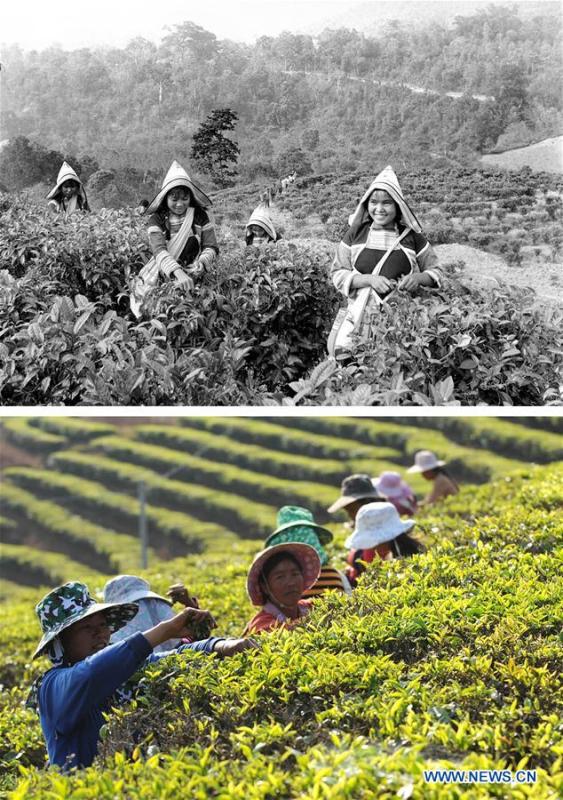
This combination photo shows Jino farmers picking tea leaves in 1984 (above, file photo); and Jino farmers working on a tea plantation in Jino Ethnic Township on Jino Mountain, Feb. 22, 2011 (below, photo by Lin Yiguang). With a population of slightly over 20,000, the Jino people had only been officially acknowledged in 1979 as an independent ethnic group of China. Until 1949, most of them had lived for generations in primitive mountain tribes in southwest China's Yunnan Province. Over the four decades since it embraced the reform and opening-up policy, China has spared no effort to support ethnic groups with smaller populations. Life on Jino Mountain, where most Jino communities are located, saw positive changes in parallel with improvements in local politics, economy, technology, education, culture, health care, ecology, ethnic development and other social undertakings. Just like its 55 ethnic brethren, the Jino people also benefit from China's reform and opening-up in seeking a prosperous life. In Jino Ethnic Township on the Jino Mountain, residents now have direct access to road, water, electricity, TV and radio, as well as the mobile network. Ninety percent of the residents have moved into new houses. Most residents own motorcycles and tractors, and some of them have purchased cars. More people have increased their income by selling local specialty products via the internet, whereas in the past, doing business was perceived as a shame. Currently, the primary education in Jino Ethnic Township achieved 100 percent coverage for all school-age children. More than 99 percent of residents have joined the rural cooperative medical insurance programme. The Jino ethnic culture undergoes protection and inheritance: the great drum dance of the Jino people has been listed as one of China's national intangible cultural heritages. (Xinhua)

Students pose for photos at the Ethnic Primary School in Jino Ethnic Township on Jino Mountain in Jinghong of Xishuangbanna Dai Autonomous Prefecture, southwest China's Yunnan Province, Nov. 20, 2018. Most of the 712 students enrolled at the school are of the Jino ethnic descent. With a population of slightly over 20,000, the Jino people had only been officially acknowledged in 1979 as an independent ethnic group of China. Until 1949, most of them had lived for generations in primitive mountain tribes in southwest China's Yunnan Province. Over the four decades since it embraced the reform and opening-up policy, China has spared no effort to support ethnic groups with smaller populations. Life on Jino Mountain, where most Jino communities are located, saw positive changes in parallel with improvements in local politics, economy, technology, education, culture, health care, ecology, ethnic development and other social undertakings. Just like its 55 ethnic brethren, the Jino people also benefit from China's reform and opening-up in seeking a prosperous life. In Jino Ethnic Township on the Jino Mountain, residents now have direct access to road, water, electricity, TV and radio, as well as the mobile network. Ninety percent of the residents have moved into new houses. Most residents own motorcycles and tractors, and some of them have purchased cars. More people have increased their income by selling local specialty products via the internet, whereas in the past, doing business was perceived as a shame. Currently, the primary education in Jino Ethnic Township achieved 100 percent coverage for all school-age children. More than 99 percent of residents have joined the rural cooperative medical insurance programme. The Jino ethnic culture undergoes protection and inheritance: the great drum dance of the Jino people has been listed as one of China's national intangible cultural heritages. (Xinhua/Lin Yiguang)
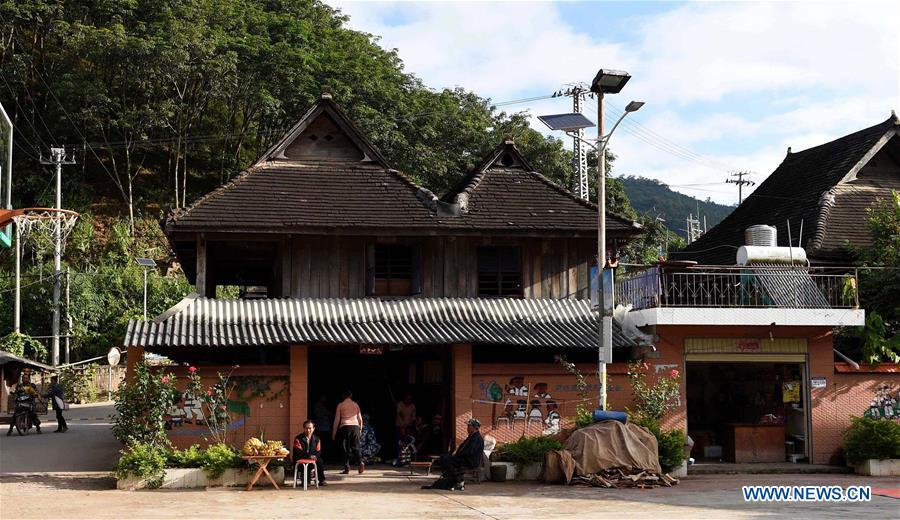
Photo taken on Nov. 5, 2015 shows a residence in Bapiao Village of Jino Ethnic Township on Jino Mountain in Jinghong of Xishuangbanna Dai Autonomous Prefecture, southwest China's Yunnan Province. Solar-power street lights are already in use in the village. With a population of slightly over 20,000, the Jino people had only been officially acknowledged in 1979 as an independent ethnic group of China. Until 1949, most of them had lived for generations in primitive mountain tribes in southwest China's Yunnan Province. Over the four decades since it embraced the reform and opening-up policy, China has spared no effort to support ethnic groups with smaller populations. Life on Jino Mountain, where most Jino communities are located, saw positive changes in parallel with improvements in local politics, economy, technology, education, culture, health care, ecology, ethnic development and other social undertakings. Just like its 55 ethnic brethren, the Jino people also benefit from China's reform and opening-up in seeking a prosperous life. In Jino Ethnic Township on the Jino Mountain, residents now have direct access to road, water, electricity, TV and radio, as well as the mobile network. Ninety percent of the residents have moved into new houses. Most residents own motorcycles and tractors, and some of them have purchased cars. More people have increased their income by selling local specialty products via the internet, whereas in the past, doing business was perceived as a shame. Currently, the primary education in Jino Ethnic Township achieved 100 percent coverage for all school-age children. More than 99 percent of residents have joined the rural cooperative medical insurance programme. The Jino ethnic culture undergoes protection and inheritance: the great drum dance of the Jino people has been listed as one of China's national intangible cultural heritages. (Xinhua/Lin Yiguang)
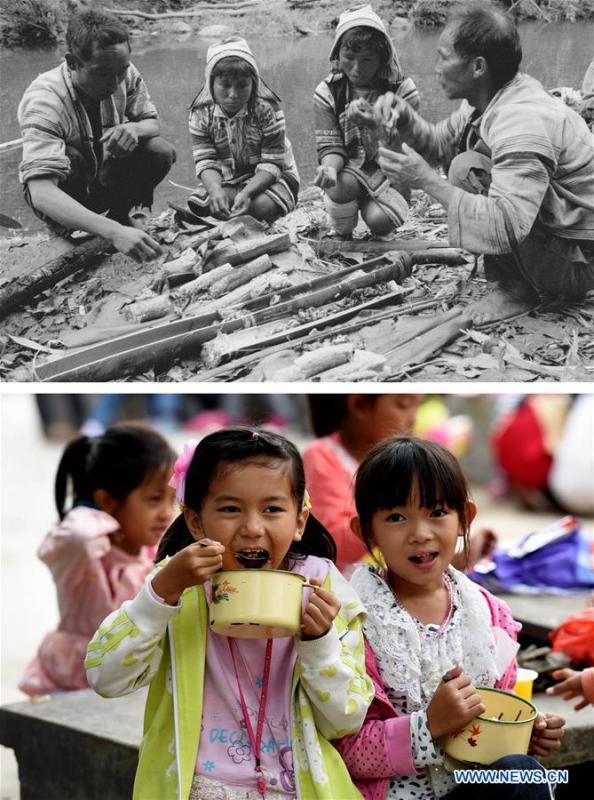
This combination photo shows Jino villagers of Jino Mountain having a riverside meal in 1983 (above, file photo); and students having free lunch at the Ethnic Primary School in Jino Ethnic Township on Jino Mountain, Nov. 4, 2015 (below, photo by Lin Yiguang). With a population of slightly over 20,000, the Jino people had only been officially acknowledged in 1979 as an independent ethnic group of China. Until 1949, most of them had lived for generations in primitive mountain tribes in southwest China's Yunnan Province. Over the four decades since it embraced the reform and opening-up policy, China has spared no effort to support ethnic groups with smaller populations. Life on Jino Mountain, where most Jino communities are located, saw positive changes in parallel with improvements in local politics, economy, technology, education, culture, health care, ecology, ethnic development and other social undertakings. Just like its 55 ethnic brethren, the Jino people also benefit from China's reform and opening-up in seeking a prosperous life. In Jino Ethnic Township on the Jino Mountain, residents now have direct access to road, water, electricity, TV and radio, as well as the mobile network. Ninety percent of the residents have moved into new houses. Most residents own motorcycles and tractors, and some of them have purchased cars. More people have increased their income by selling local specialty products via the internet, whereas in the past, doing business was perceived as a shame. Currently, the primary education in Jino Ethnic Township achieved 100 percent coverage for all school-age children. More than 99 percent of residents have joined the rural cooperative medical insurance programme. The Jino ethnic culture undergoes protection and inheritance: the great drum dance of the Jino people has been listed as one of China's national intangible cultural heritages. (Xinhua)
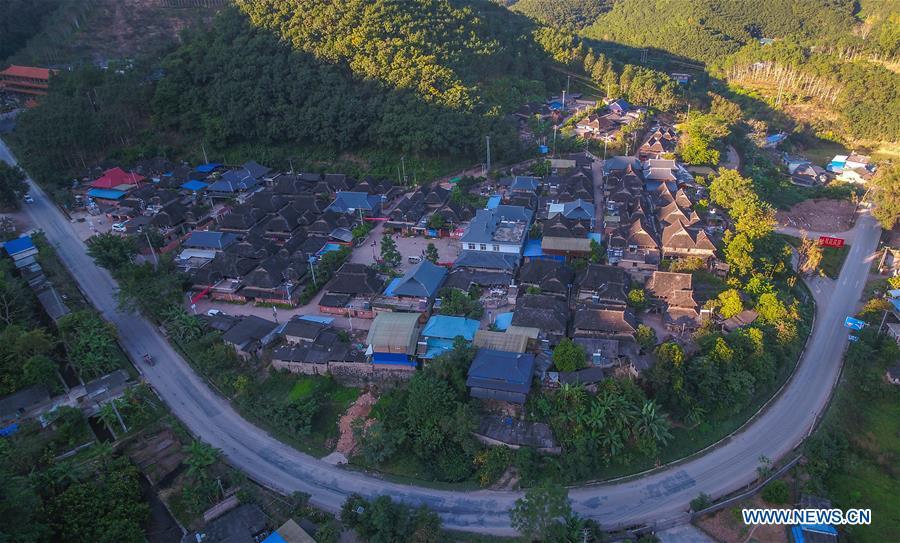
Aerial photo taken on Nov. 20, 2018 shows a corner of Bapiao Village in Jino Ethnic Township on Jino Mountain in Jinghong of Xishuangbanna Dai Autonomous Prefecture, southwest China's Yunnan Province. With a population of slightly over 20,000, the Jino people had only been officially acknowledged in 1979 as an independent ethnic group of China. Until 1949, most of them had lived for generations in primitive mountain tribes in southwest China's Yunnan Province. Over the four decades since it embraced the reform and opening-up policy, China has spared no effort to support ethnic groups with smaller populations. Life on Jino Mountain, where most Jino communities are located, saw positive changes in parallel with improvements in local politics, economy, technology, education, culture, health care, ecology, ethnic development and other social undertakings. Just like its 55 ethnic brethren, the Jino people also benefit from China's reform and opening-up in seeking a prosperous life. In Jino Ethnic Township on the Jino Mountain, residents now have direct access to road, water, electricity, TV and radio, as well as the mobile network. Ninety percent of the residents have moved into new houses. Most residents own motorcycles and tractors, and some of them have purchased cars. More people have increased their income by selling local specialty products via the internet, whereas in the past, doing business was perceived as a shame. Currently, the primary education in Jino Ethnic Township achieved 100 percent coverage for all school-age children. More than 99 percent of residents have joined the rural cooperative medical insurance programme. The Jino ethnic culture undergoes protection and inheritance: the great drum dance of the Jino people has been listed as one of China's national intangible cultural heritages. (Xinhua/Yang Muyuan)
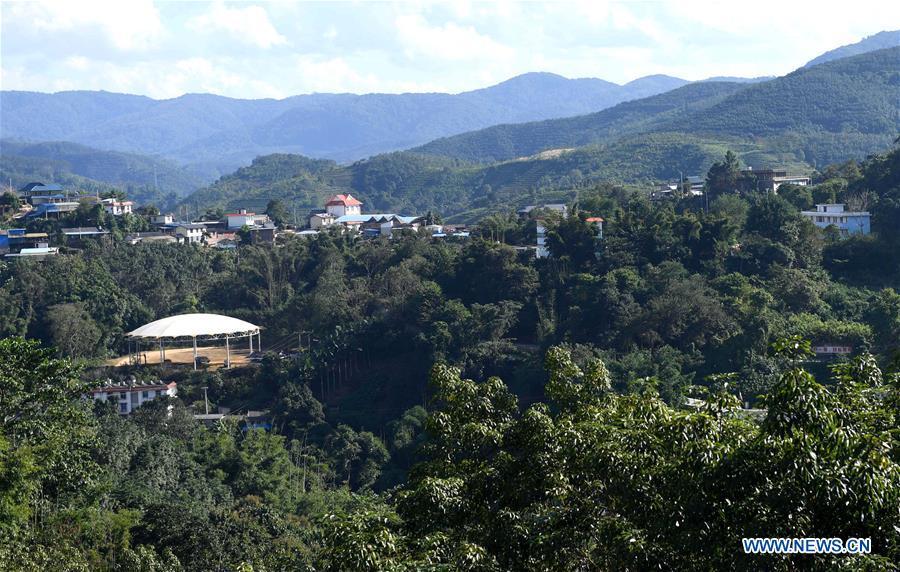
Aerial photo taken on Nov. 20, 2018 shows a view of the Jino Ethnic Township on Jino Mountain in Jinghong of Xishuangbanna Dai Autonomous Prefecture, southwest China's Yunnan Province. With a population of slightly over 20,000, the Jino people had only been officially acknowledged in 1979 as an independent ethnic group of China. Until 1949, most of them had lived for generations in primitive mountain tribes in southwest China's Yunnan Province. Over the four decades since it embraced the reform and opening-up policy, China has spared no effort to support ethnic groups with smaller populations. Life on Jino Mountain, where most Jino communities are located, saw positive changes in parallel with improvements in local politics, economy, technology, education, culture, health care, ecology, ethnic development and other social undertakings. Just like its 55 ethnic brethren, the Jino people also benefit from China's reform and opening-up in seeking a prosperous life. In Jino Ethnic Township on the Jino Mountain, residents now have direct access to road, water, electricity, TV and radio, as well as the mobile network. Ninety percent of the residents have moved into new houses. Most residents own motorcycles and tractors, and some of them have purchased cars. More people have increased their income by selling local specialty products via the internet, whereas in the past, doing business was perceived as a shame. Currently, the primary education in Jino Ethnic Township achieved 100 percent coverage for all school-age children. More than 99 percent of residents have joined the rural cooperative medical insurance programme. The Jino ethnic culture undergoes protection and inheritance: the great drum dance of the Jino people has been listed as one of China's national intangible cultural heritages. (Xinhua/Lin Yiguang)
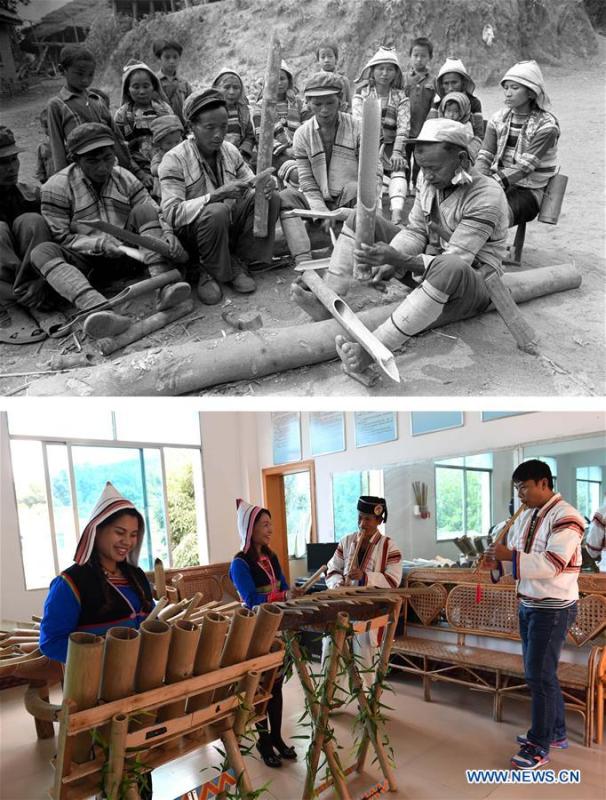
This combination photo shows Jino villagers performing with bamboo musical instruments in 1988 (above, file photo); and culture promotion workers performing with ethnic musical instruments in Jino Ethnic Township on Jino Mountain, Nov. 5, 2015 (below, photo by Lin Yiguang). With a population of slightly over 20,000, the Jino people had only been officially acknowledged in 1979 as an independent ethnic group of China. Until 1949, most of them had lived for generations in primitive mountain tribes in southwest China's Yunnan Province. Over the four decades since it embraced the reform and opening-up policy, China has spared no effort to support ethnic groups with smaller populations. Life on Jino Mountain, where most Jino communities are located, saw positive changes in parallel with improvements in local politics, economy, technology, education, culture, health care, ecology, ethnic development and other social undertakings. Just like its 55 ethnic brethren, the Jino people also benefit from China's reform and opening-up in seeking a prosperous life. In Jino Ethnic Township on the Jino Mountain, residents now have direct access to road, water, electricity, TV and radio, as well as the mobile network. Ninety percent of the residents have moved into new houses. Most residents own motorcycles and tractors, and some of them have purchased cars. More people have increased their income by selling local specialty products via the internet, whereas in the past, doing business was perceived as a shame. Currently, the primary education in Jino Ethnic Township achieved 100 percent coverage for all school-age children. More than 99 percent of residents have joined the rural cooperative medical insurance programme. The Jino ethnic culture undergoes protection and inheritance: the great drum dance of the Jino people has been listed as one of China's national intangible cultural heritages. (Xinhua)











